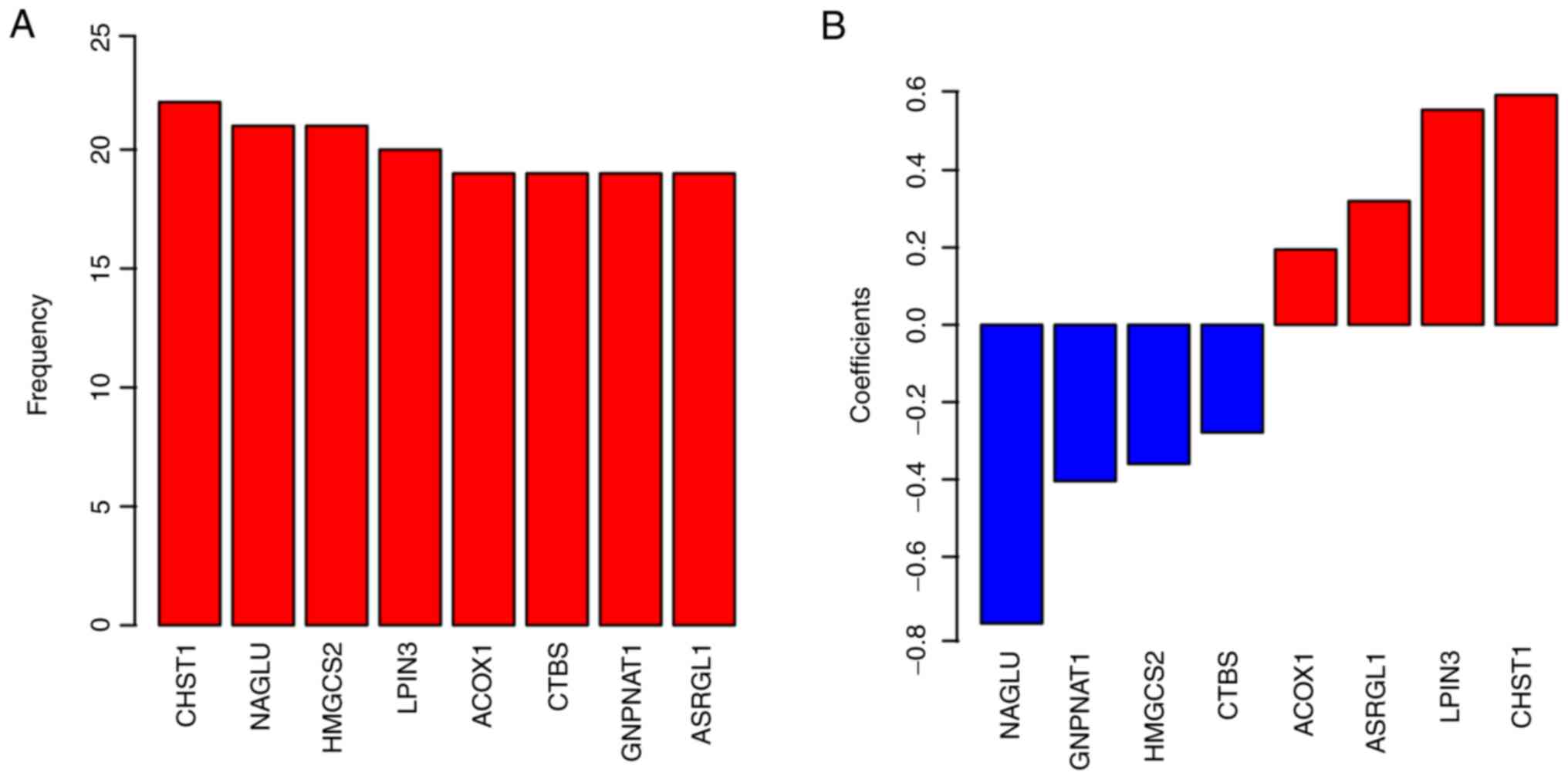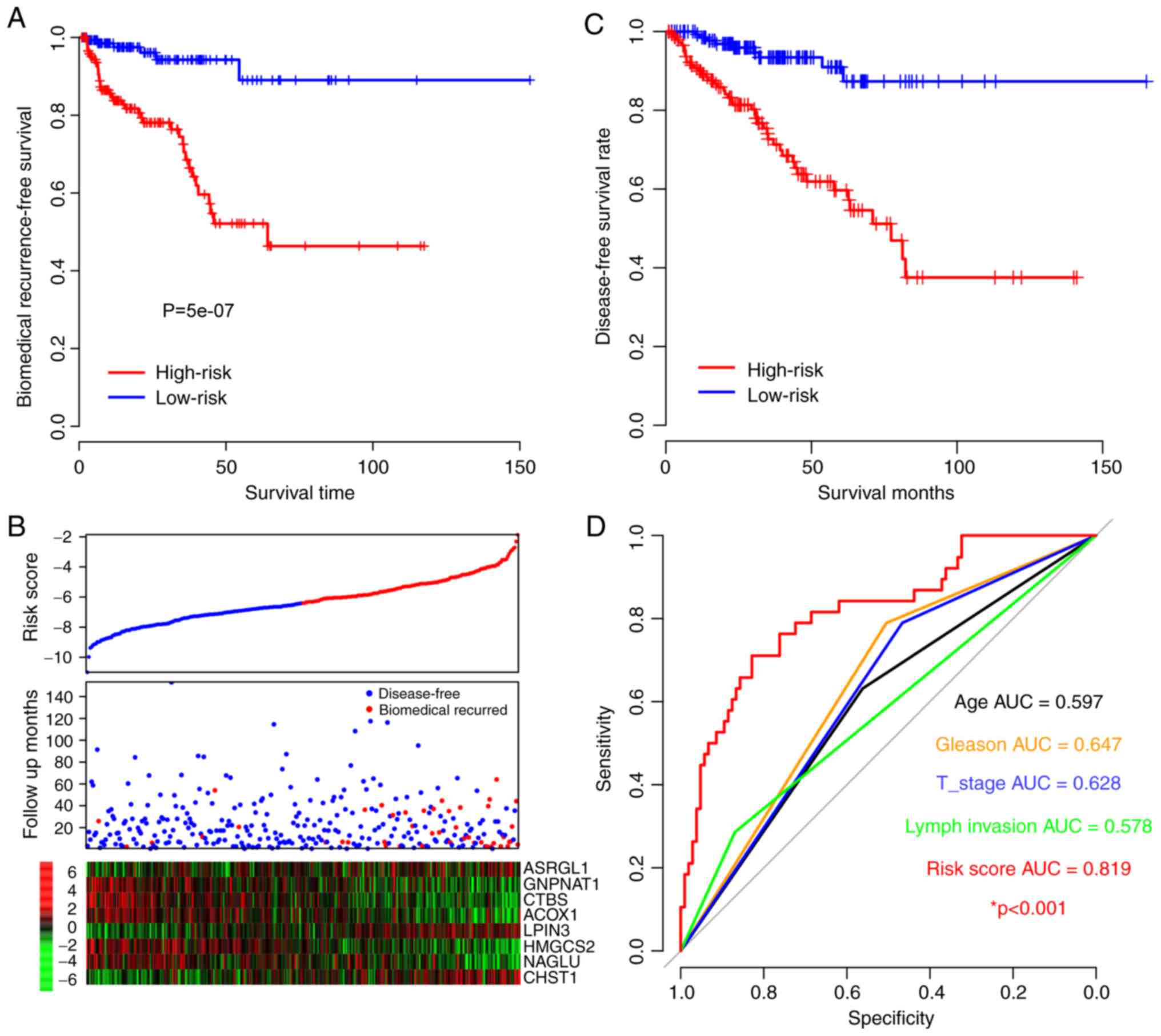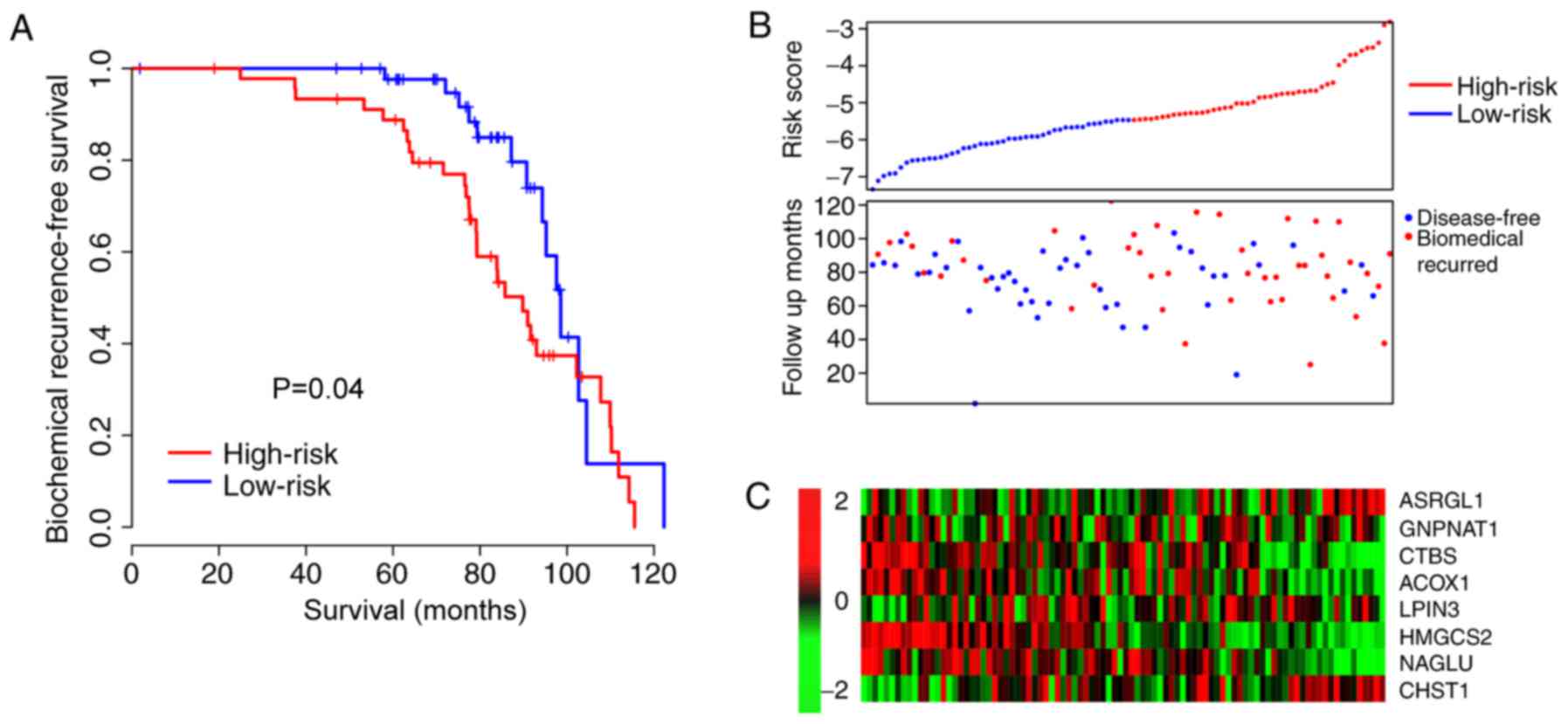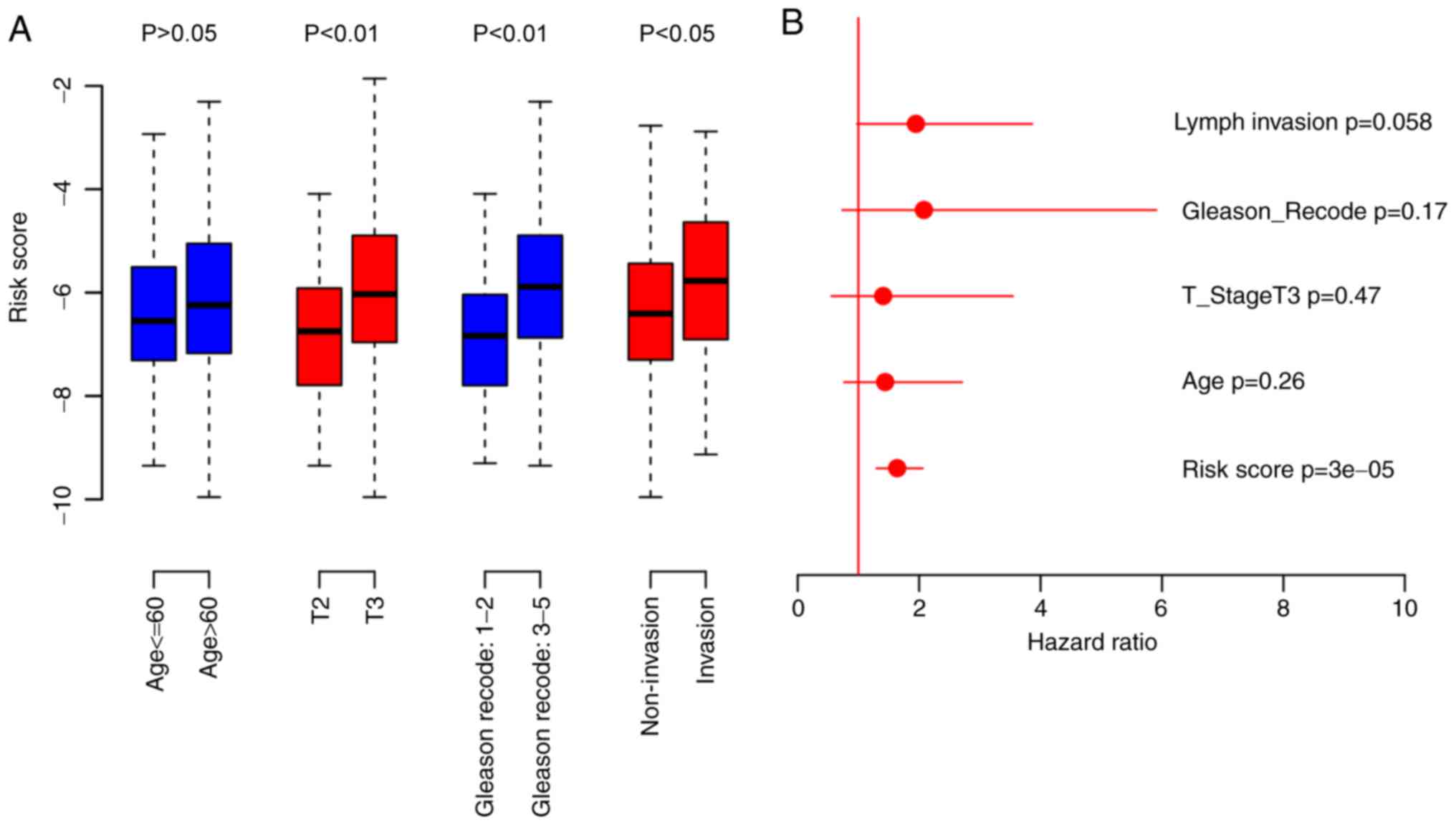Identification of genes that predict the biochemical recurrence of prostate cancer
- Authors:
- Published online on: July 10, 2018 https://doi.org/10.3892/ol.2018.9106
- Pages: 3447-3452
-
Copyright: © Chu et al. This is an open access article distributed under the terms of Creative Commons Attribution License.
Abstract
Introduction
Prostate cancer (PCa) is one of the most prevalent cancer types in men; in 2015, there were 60,300 newly diagnosed cases of PCa in China, resulting in 26,000 mortalities (1). Disease recurrence has been reported in a large proportion of patients following radical prostatectomy (2), and castration-resistant disease typically develops as a result (3,4). Although prognostic and clinical indicators were implemented, the prognostic effect was not fully understood (5). Thus, clinical biomarkers for PCa biochemical recurrence are required. Huang et al (6) used long non-coding RNAs to develop a prediction model for biochemical recurrence; however, the analysis lacked validation datasets.
Over the previous decade, single biomarkers have been identified for the prognosis of PCa (7–9); however, the utilization of these biomarkers requires further investigation owing to the heterogeneity of PCa (10). Multiple gene-based studies of prognostic biomarkers are currently prevalent owing to their robustness in multiple different cancer types (11–17).
By associating gene expression and survival information from The Cancer Genome Atlas (TCGA), survival-associated genes were identified. Using a random forest-based variable hunting approach, eight genes were selected and a risk score staging system was developed. Patients with high-risk scores had significantly poorer survival rates compared with patients with low-risk scores. This result was further validated using an independent dataset from the National Center for Biotechnology Information (NCBI), GSE70769 (18). Analysis of clinicopathological factors revealed that the risk score was independent of age but was significantly associated with Tumor Node Metastasis (TNM) stage (19), lymph node invasion and Gleason score. Cox multivariate regression and the 5-year biochemical recurrence area under the receiver operating curve (ROC) reveal that the risk score was an important indicator for prediction of biochemical recurrence.
Materials and methods
Data pre-processing
Raw microarray data of the NCBI dataset GSE70769 was downloaded from Gene Expression Omnibus (https://www.ncbi.nlm.nih.gov/geo) (20). Subsequent to background correction and normalization using the Robust Multi-Array Averaging (RMA) approach (21), the data was used for further analysis. The probe names were annotated according to the manufacturer's annotation file. For genes matching multiple probes, the average values were calculated and used as the expression values for the corresponding genes. TCGA gene expression (https://cancergenome.nih.gov/) data was downloaded from University of California Santa Cruz Xena and converted to fragments per kilobase of transcript sequence per million base pairs sequenced (FPKM) values. The log 2-transformed RNA-Sequence by expectation-maximization values were retained for model development.
Prediction gene selection, Cox multivariate regression model and validation
Cox univariate regression was performed on TCGA dataset. Genes with relative expression levels associated with biochemical recurrence-free survival (BFS) were retained for a further forest-based variable hunting approach, performed as previously described (22,23). Following 100 repeats and 100 iterations, genes from the top of the list were selected for further analysis. Finally, eight genes were identified as the most frequently present in the repeats and iterations, thus these eight genes were selected for model development. Next, multivariate Cox regression was performed using the aforementioned genes to construct a linear risk-score model. In the validation datasets, coefficients were locked and the risk score for each sample was calculated. The risk score was calculated using the following formula; where βi indicates the coefficients evaluated with gene expression and xi refers to the relative gene expression level.
Risk score=∑inβi*xiFor the training dataset, the samples were divided into low- and high-risk groups according to the median risk score using R software (v3.0.1; http://cran.r-project.org/doc/FAQ/R-FAQ.html) and packages (24,25).
Statistical analysis
Background correction and RMA normalization of raw Affymetrix CEL data were performed using the ‘RMA’ function in the ‘affy’ package (v1.56.0) (26). The survival difference between the high-risk and low-risk groups, univariate regression in the training dataset, multivariate Cox proportional hazard model development and multivariate regression with risk score and other clinical indicators were performed using the ‘survival’ function in the R package (v1.4–8). The ROCs were drawn and the area under curve (AUC) calculation was performed using the R package, ‘pROC’ (v1.11.0) (27). All statistical analysis was performed using R software and packages. P<0.05 was considered to indicate a statistically significant difference.
Results
Identification of survival-associated genes
Univariate Cox regression was performed on TCGA dataset, following filtering of the non-primary PCa tissues, by associating BFS and gene expression. Detailed information of the samples enrolled in TCGA dataset are presented in Table I. Genes significantly associated with BFS (P<0.01) were retained for further analysis. As the identified gene panel was relatively large, a random forest-based variable hunting approach was implemented to retrieve the best combination of biomarkers. Eight genes were selected for further model development (Fig. 1A; Table II). Finally, the coefficients are presented in Fig. 1B. The positive coefficients suggest that the genes are oncogenes, while the negative coefficients indicate tumor suppressor genes.
Performance of risk score in the training dataset
To assess the prognostic value of the risk score model, the survival difference between high- and low-risk scores (using the median value as the cut-off) was compared to evaluate the performance of the risk score. According to the results, the BFS in the high-risk-score group was significantly shorter compared with the low-risk score group (P=5×10−7; Fig. 2A). As presented in Fig. 2A, samples with early biomedical recurrence were characterized with a high expression of asparaginase like 1 (ASRGL1), lipin 3 and carbohydrate sulfotransferase 1. However, patients without biochemical recurrence presented with a high expression of glucosamine-phosphate N-acetyltransferase 1 (GNPNAT1), chitobiase, acyl-CoA oxidase 1 (ACOX1), 3-hydroxy-3-methylglutaryl-CoA synthase 2 (HMGCS2) and N-acetyl-α-glucosaminidase (NAGLU), which was consistent with the coefficients (Figs. 1B and 2B). Disease-free survival time was additionally compared between the high- and low-risk groups and the result was similar to the BFS pattern as the survival of the high-risk group was notably lower compared with that of the low-risk group (Fig. 2C). The 5-year BFS ROC was identified to be an effective method to compare the prognostic value of the risk score and other clinicopathological observations (Fig. 2D). The AUCs of age, Gleason index, primary tumor stage, lymph node invasion and risk score were 0.597, 0.647, 0.628, 0.578 and 0.819, respectively. Specifically, it is indicated that the mortality risk of patients with the highest risk scores was very high. These results indicate that the risk score is better at predicting BFS than the other clinical observations.
Validation of risk score performance
The high performance of the risk score may have resulted from the over-fit dataset. To test if over-fitness existed, the coefficients were locked in order to evaluate the robustness of this model, and the risk scores were calculated for an independent NCBI dataset (GSE70769). The samples from the independent dataset were additionally divvied into high- and low-risk groups, as with the training dataset. The results were similar to the BFS profile of the training dataset. The BFS of patients in the high-risk-score group were significantly shorter than the low-risk-score group (P=0.04; Fig. 3A) and associated with early biomedical recurrence (Fig. 3B). The expression profile was additionally similar to that of the training dataset (Fig. 3C). These results indicate that the risk score is a robust indicator for PCa prognosis.
Association between risk score and other clinical information
Analyses of risk score and clinical information were performed. The results indicated that the risk score was significantly associated with primary tumor stage (P<0.05), Gleason score (P<0.01) and lymph invasion (P<0.01), but not with age (Fig. 4A). Cox multivariate regression was performed using the risk score and the aforementioned clinical observations. The risk score was the only prognostic indicator identified to be significantly associated with biochemical recurrence (P=3×10−5; Fig. 4B). In summary, these results indicate that risk score is an important clinical indicator of PCa prognosis.
Discussion
Despite the low rate of progression, biomedical recurrence and metastasis continue to be observed in a large proportion of patients with PCa (28). Thus, prognostic biomarkers are urgently required. Over the previous decade, single biomarkers have been reported to predict the survival of patients with PCa (3,9,29). However, the single-biomarker approach to cancer prognosis assessment is less robust compared with the more widely reported multiple-biomarker-based models (30–32). Using machine learning and gene expression, the present study developed a Cox multivariate regression-based risk score model. The model was then further evaluated for performance and robustness. The risk score staging system performed well in predicting survival in two datasets from different microarray platforms.
Among the candidate genes selected, serum NAGLU has been reported to be associated with the clinical indicators and survival of gastrointestinal adenocarcinoma (33); and the expression of another gene, GNPNAT1, had been demonstrated to be associated with the progression of castration-resistant PCa (34) via the phosphatidylinositol3-kinase/protein kinase B signaling pathway. Proteomics analysis revealed that HMGCS2 expression is altered in PCa, and that the expression of this gene is associated with the survival of squamous cell carcinoma following surgery (35,36). It has additionally been revealed to affect the extracellular signal-regulated kinase/c-Jun signaling pathway in hepatocellular carcinoma (37). In addition, ACOX1 has been reported to be associated with migration and metastasis in the xenografts of colorectal carcinoma (38), and associated with the mitogen-activated protein kinase signaling pathway in hepatocellular carcinoma (39). A similar function was detected for ASRGL1 in endometrial carcinoma (39), although the underlying mechanism remains unclear. Collectively, these results indicate that the candidate genes used in the model are reliable, thus reinforcing the robustness of the model.
In a previous study, Huang et al (6) used gene expression to predict biochemical recurrence using TCGA expression data, the study lacked a validation dataset. The present study was novel as it developed a robust prediction model for PCa that was validated using another platform. Indeed, the RNA-sequencing data was presented with log2-transformed FPKM values, whereas microarray data was presented as log2-transformed intensity values. The formula was calculated using the relative gene expression level, regardless of its unit. This may explain why this model is functional across different platforms.
However, limitations of the present study exist. Firstly, the present study is a retrospective study. The clinical information and long-term follow-up are unavailable, and detailed clinical information are unavailable. Thus, bias may have resulted. Secondly, although the robustness of the risk score was validated using another dataset, the clinical utilization of the risk score requires further studies in order to fully confirm its efficiency. The present findings may provide novel insights for predicting the biochemical recurrence of patients with PCa.
References
|
Chen W, Zheng R, Baade PD, Zhang S, Zeng H, Bray F, Jemal A, Yu XQ and He J: Cancer statistics in china, 2015. CA Cancer J Clin. 66:115–132. 2016. View Article : Google Scholar : PubMed/NCBI | |
|
Brockman JA, Alanee S, Vickers AJ, Scardino PT, Wood DP, Kibel AS, Lin DW, Bianco FJ Jr, Rabah DM, Klein EA, et al: Nomogram predicting prostate cancer-specific mortality for men with biochemical recurrence after radical prostatectomy. Eur Urol. 67:1160–1167. 2015. View Article : Google Scholar : PubMed/NCBI | |
|
Torrecilla Lopez J, Hervas A, Zapatero A, Gómez Caamaño A, Macías V, Herruzo I, Maldonado X, Iturriaga Gómez A, Casas F and Segundo González San C: Uroncor consensus statement: Management of biochemical recurrence after radical radiotherapy for prostate cancer: From biochemical failure to castration resistance. Rep Pract Oncol Radiother. 20:259–272. 2015. View Article : Google Scholar : PubMed/NCBI | |
|
Algarra R, Hevia M, Tienza A, Merino I, Velis JM, Zudaire J, Robles JE and Pascual I: Survival analysis of patients with biochemical relapse after radical prostatectomy treated with androgen deprivation: Castration-resistance influential factors. Can Urol Assoc J. 8:E333–E341. 2014. View Article : Google Scholar : PubMed/NCBI | |
|
Epstein JI, Zelefsky MJ, Sjoberg DD, Nelson JB, Egevad L, Magi-Galluzzi C, Vickers AJ, Parwani AV, Reuter VE, Fine SW, et al: A contemporary prostate cancer grading system: A validated alternative to the gleason score. Eur Urol. 69:428–435. 2016. View Article : Google Scholar : PubMed/NCBI | |
|
Huang TB, Dong CP, Zhou GC, Lu SM, Luan Y, Gu X, Liu L and Ding XF: A potential panel of four-long noncoding RNA signature in prostate cancer predicts biochemical recurrence-free survival and disease-free survival. Int Urol Nephrol. 49:825–835. 2017. View Article : Google Scholar : PubMed/NCBI | |
|
Zhang H, Cheng S, Wang A, Ma H, Yao B, Qi C, Liu R, Qi S and Xu Y: Expression of RABEX-5 and its clinical significance in prostate cancer. J Exp Clin Cancer Res. 33:312014. View Article : Google Scholar : PubMed/NCBI | |
|
Chiang YT, Wang K, Fazli L, Qi RZ, Gleave ME, Collins CC, Gout PW and Wang Y: GATA2 as a potential metastasis-driving gene in prostate cancer. Oncotarget. 5:451–461. 2014. View Article : Google Scholar : PubMed/NCBI | |
|
Zhang L, Guo F, Gao X and Wu Y: Golgi phosphoprotein 3 expression predicts poor prognosis in patients with prostate cancer undergoing radical prostatectomy. Mol Med Rep. 12:1298–1304. 2015. View Article : Google Scholar : PubMed/NCBI | |
|
Amaro A, Esposito AI, Gallina A, Nees M, Angelini G, Albini A and Pfeffer U: Validation of proposed prostate cancer biomarkers with gene expression data: A long road to travel. Cancer Metastasis Rev. 33:657–671. 2014. View Article : Google Scholar : PubMed/NCBI | |
|
Samra Bou E, Klein B, Commes T and Moreaux J: Development of gene expression-based risk score in cytogenetically normal acute myeloid leukemia patients. Oncotarget. 3:824–832. 2012. View Article : Google Scholar : PubMed/NCBI | |
|
Ito H, Mo Q, Qin LX, Viale A, Maithel SK, Maker AV, Shia J, Kingham P, Allen P, DeMatteo RP, et al: Gene expression profiles accurately predict outcome following liver resection in patients with metastatic colorectal cancer. PloS One. 8:e816802013. View Article : Google Scholar : PubMed/NCBI | |
|
Chang W, Gao X, Han Y, Du Y, Liu Q, Wang L, Tan X, Zhang Q, Liu Y, Zhu Y, et al: Gene expression profiling-derived immunohistochemistry signature with high prognostic value in colorectal carcinoma. Gut. 63:1457–1467. 2014. View Article : Google Scholar : PubMed/NCBI | |
|
Salazar R, Roepman P, Capella G, Moreno V, Simon I, Dreezen C, Lopez-Doriga A, Santos C, Marijnen C, Westerga J, et al: Gene expression signature to improve prognosis prediction of stage II and III colorectal cancer. J Clin Oncol. 29:17–24. 2011. View Article : Google Scholar : PubMed/NCBI | |
|
Samra Bou E, Klein B, Commes T and Moreaux J: Identification of a 20-gene expression-based risk score as a predictor of clinical outcome in chronic lymphocytic leukemia patients. Biomed Res Int. 2014:4231742014.PubMed/NCBI | |
|
Kim SK, Kim SY, Kim JH, Roh SA, Cho DH, Kim YS and Kim JC: A nineteen gene-based risk score classifier predicts prognosis of colorectal cancer patients. Mol Oncol. 8:1653–1666. 2014. View Article : Google Scholar : PubMed/NCBI | |
|
Zhang ZL, Zhao LJ, Chai L, Zhou SH, Wang F, Wei Y, Xu YP and Zhao P: Seven LncRNA-mRNA based risk score predicts the survival of head and neck squamous cell carcinoma. Sci Rep. 7:3092017. View Article : Google Scholar : PubMed/NCBI | |
|
Ross-Adams H, Lamb AD, Dunning MJ, Halim S, Lindberg J, Massie CM, Egevad LA, Russell R, Ramos-Montoya A, Vowler SL, et al: Integration of copy number and transcriptomics provides risk stratification in prostate cancer: A discovery and validation cohort study. EBioMedicine. 2:1133–1144. 2015. View Article : Google Scholar : PubMed/NCBI | |
|
Kim KH, Yang SS, Yoon YS, Lim SB, Yu CS and Kim JC: Validation of the seventh edition of the american joint committee on cancer tumor-node-metastasis (AJCC TNM) staging in patients with stage II and stage III colorectal carcinoma: Analysis of 2511 cases from a medical centre in korea. Colorectal Dis. 13:e220–e226. 2011. View Article : Google Scholar : PubMed/NCBI | |
|
Edgar R, Domrachev M and Lash AE: Gene expression omnibus: NCBI gene expression and hybridization array data repository. Nucleic Acids Res. 30:207–210. 2002. View Article : Google Scholar : PubMed/NCBI | |
|
Katz S, Irizarry RA, Lin X, Tripputi M and Porter MW: A summarization approach for affymetrix genechip data using a reference training set from a large, biologically diverse database. BMC Bioinformatics. 7:4642006. View Article : Google Scholar : PubMed/NCBI | |
|
Ishwaran H and Kogalur UB: Consistency of random survival forests. Stat Probab Lett. 80:1056–1064. 2010. View Article : Google Scholar : PubMed/NCBI | |
|
Ishwaran H, Gerds TA, Kogalur UB, Moore RD, Gange SJ and Lau BM: Random survival forests for competing risks. Biostatistics. 15:757–773. 2014. View Article : Google Scholar : PubMed/NCBI | |
|
Gautier L, Cope L, Bolstad BM and Irizarry RA: affy-analysis of affymetrix genechip data at the probe level. Bioinformatics. 20:307–315. 2004. View Article : Google Scholar : PubMed/NCBI | |
|
Liu Z and Pounds S: An R package that automatically collects and archives details for reproducible computing. BMC Bioinformatics. 15:1382014. View Article : Google Scholar : PubMed/NCBI | |
|
Charlop-Powers Z and Brady SF: Phylogeo: An R package for geographic analysis and visualization of microbiome data. Bioinformatics. 31:2909–2911. 2015. View Article : Google Scholar : PubMed/NCBI | |
|
Robin X, Turck N, Hainard A, Tiberti N, Lisacek F, Sanchez JC and Müller M: pROC: An open-source package for R and S+ to analyze and compare ROC curves. BMC Bioinformatics. 12:772011. View Article : Google Scholar : PubMed/NCBI | |
|
Kim R: Anesthetic technique and cancer recurrence in oncologic surgery: Unraveling the puzzle. Cancer Metastasis Rev. 36:159–177. 2017. View Article : Google Scholar : PubMed/NCBI | |
|
Chen J, Miao Z, Xue B, Shan Y, Weng G and Shen B: Long non-coding RNAs in urologic malignancies: Functional roles and clinical translation. J Cancer. 7:1842–1855. 2016. View Article : Google Scholar : PubMed/NCBI | |
|
Nimse SB, Sonawane MD, Son KS and Kim T: Biomarker detection technologies and future directions. Analyst. 141:740–755. 2016. View Article : Google Scholar : PubMed/NCBI | |
|
Tian X, Zhu X, Yan T, Yu C, Shen C, Hong J, Chen H and Fang JY: Differentially expressed lncrnas in gastric cancer patients: A potential biomarker for gastric cancer prognosis. J Cancer. 8:2575–2586. 2017. View Article : Google Scholar : PubMed/NCBI | |
|
Bensalah K, Lotan Y, Karam JA and Shariat SF: New circulating biomarkers for prostate cancer. Prostate Cancer Prostatic Dis. 11:112–120. 2008. View Article : Google Scholar : PubMed/NCBI | |
|
Gupta D and Lis CG: Pretreatment serum albumin as a predictor of cancer survival: A systematic review of the epidemiological literature. Nutr J. 9:692010. View Article : Google Scholar : PubMed/NCBI | |
|
Kaushik AK, Shojaie A, Panzitt K, Sonavane R, Venghatakrishnan H, Manikkam M, Zaslavsky A, Putluri V, Vasu VT, Zhang Y, et al: Inhibition of the hexosamine biosynthetic pathway promotes castration-resistant prostate cancer. Net Commun. 7:116122016. View Article : Google Scholar | |
|
Tang H, Wu Y, Qin Y, Wang H, Jia Y, Yang S, Luo S and Wang Q: Predictive significance of HMGCS2 for prognosis in resected Chinese esophageal squamous cell carcinoma patients. OncoTargets Ther. 10:2553–2560. 2017. View Article : Google Scholar | |
|
Saraon P, Cretu D, Musrap N, Karagiannis GS, Batruch I, Drabovich AP, van der Kwast T, Mizokami A, Morrissey C, Jarvi K and Diamandis EP: Quantitative proteomics reveals that enzymes of the ketogenic pathway are associated with prostate cancer progression. Mol Cell Proteomics. 12:1589–1601. 2013. View Article : Google Scholar : PubMed/NCBI | |
|
Su SG, Yang M, Zhang MF, Peng QZ, Li MY, Liu LP and Bao SY: miR-107-mediated decrease of HMGCS2 indicates poor outcomes and promotes cell migration in hepatocellular carcinoma. Int J Biochem Cell Biol. 91:53–59. 2017. View Article : Google Scholar : PubMed/NCBI | |
|
Sun LN, Zhi Z, Chen LY, Zhou Q, Li XM, Gan WJ, Chen S, Yang M, Liu Y, Shen T, et al: SIRT1 suppresses colorectal cancer metastasis by transcriptional repression of miR-15b-5p. Cancer Lett. 409:104–115. 2017. View Article : Google Scholar : PubMed/NCBI | |
|
Edqvist PH, Huvila J, Forsstrom B, Talve L, Carpén O, Salvesen HB, Krakstad C, Grénman S, Johannesson H, Ljungqvist O, et al: Loss of ASRGL1 expression is an independent biomarker for disease-specific survival in endometrioid endometrial carcinoma. Gynecol Oncol. 137:529–537. 2015. View Article : Google Scholar : PubMed/NCBI |













